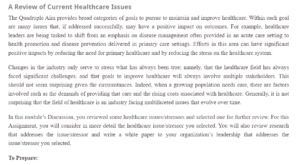A Review of Current Healthcare Issues
Without a doubt, in addition to advanced education practices, one of the primary healthcare issues facing Americans today is the rising cost of care (Auerbach, Staiger, & Buerhaus, 2018). Even with federal subsidy programs (such as Medicare and Medicaid) as well as national policies (like the Affordable Care Act), Americans still spend more on healthcare compared to any other developed country (Park et al., 2018). The costs are increasing each year even as the government increases its budgetary allocation to healthcare. For example, in the 2017 financial year, the U.S. spent a total of $3.5 trillion (which represents 18% of the gross domestic product) on healthcare services – a figure that is more than double the average amount spent by most developed European economies (Committee for a Responsible Federal Budget, 2018).
The rising cost of care has impacted my workplace in so many ways. Specifically, for us working in a private healthcare insurance firm, it has reduced the enrollment of families (staff members) in EBPI (employment-based private insurance) plans by the organization because it is too expensive (Yu & Dick, 2012). The company is also overworking us, and most are demoralized simply because it cannot add more staff members to avoid paying EBPI. In response to the increasing costs of care, which have also left most employees uninsured, our organization has taken the initiative to lobby for policy changes to reduce the premiums, co-pays, and deductibles associated with EBPI. The belief is that with a relatively lower EBPI, the company can afford to hire more staff members and pay for their employment insurance plans. Our organization is also pushing for the federal government to increase the tax subsidy provided to employers with more workers – an initiative that will increase participation (Buchmueller & Monheit, 2009). Finally, we are pushing for the government to implement managed care as the defining insurance plan and persuade the government to maintain the employee-based care system.
References
Auerbach, D. I., Staiger, D. O., &Buerhaus, P. I. (2018). Growing ranks of advanced practice clinicians—Implications for the physician workforce. New England Journal of Medicine, 378(25), 2358–2360. doi:10.1056/NEJMp1801869
Buchmueller, T. C., & Monheit, A. C. (2009). Employer-sponsored health insurance and the promise of health insurance. Inquiry, 46, 187-202. Retrieved from https://journals.sagepub.com/doi/pdf/10.5034/inquiryjrnl_46.02.187
Committee for a Responsible Federal Budget. (2018). American health care: Health spending and the federal budget. Retrieved from http://www.crfb.org/papers/american-health-care-health-spending-and-federal-budget
Park, B., et al. (2018). How evolving United States payment models influence primary care and its impact on the Quadruple Aim. Journal of the American Board of Family Medicine, 31(4), 588–604. doi:10.3122/jabfm.2018.04.170388
Yu, H., & Dick, A. W. (2012). Impacts of rising health care costs on families with employment-based private insurance: A national analysis with state fixed effects. Health Services Research, 47(5), 2012-2030. doi: 10.1111/j.1475-6773.2012.01397.x
ORDER A PLAGIARISM-FREE PAPER HERE
We’ll write everything from scratch
Question
A Review of Current Healthcare Issues
The Quadruple Aim provides broad categories of goals to pursue to maintain and improve healthcare. Within each goal are many issues that, if addressed successfully, may have a positive impact on outcomes. For example, healthcare leaders are being tasked to shift from an emphasis on disease management often provided in an acute care setting to health promotion and disease prevention delivered in primary care settings. Efforts in this area can have significant positive impacts by reducing the need for primary healthcare and by reducing the stress on the healthcare system.
Changes in the industry only serve to stress what has always been true; namely, that the healthcare field has always faced significant challenges, and that goals to improve healthcare will always involve multiple stakeholders. This should not seem surprising given the circumstances. Indeed, when a growing population needs care, there are factors involved such as the demands of providing that care and the rising costs associated with healthcare. Generally, it is not surprising that the field of healthcare is an industry facing multifaceted issues that evolve over time.
In this module’s Discussion, you reviewed some healthcare issues/stressors and selected one for further review. For this Assignment, you will consider in more detail the healthcare issue/stressor you selected. You will also review research that addresses the issue/stressor and write a white paper to your organization’s leadership that addresses the issue/stressor you selected.
To Prepare:
- Review the national healthcare issues/stressors presented in the Resources and reflect on the national healthcare issue/stressor you selected for study.
A Review of Current Healthcare Issues
- Reflect on the feedback you received from your colleagues on your Discussion post for the national healthcare issue/stressor you selected.
- Identify and review two additional scholarly resources (not included in the Resources for this module) that focus on change strategies implemented by healthcare organizations to address your selected national healthcare issue/stressor.
The Assignment (3-4 Pages):
Analysis of a Pertinent Healthcare Issue
Develop a 3- to 4-page paper, written to your organization’s leadership team, addressing your selected national healthcare issue/stressor and how it is impacting your work setting. Be sure to address the following:
- Describe the national healthcare issue/stressor you selected and its impact on your organization. Use organizational data to quantify the impact (if necessary, seek assistance from leadership or appropriate stakeholders in your organization).
- Provide a brief summary of the two articles you reviewed from outside resources on the national healthcare issue/stressor. Explain how the healthcare issue/stressor is being addressed in other organizations.
- Summarize the strategies used to address the organizational impact of national healthcare issues/stressors presented in the scholarly resources you selected. Explain how they may impact your organization both positively and negatively. Be specific and provide examples.


